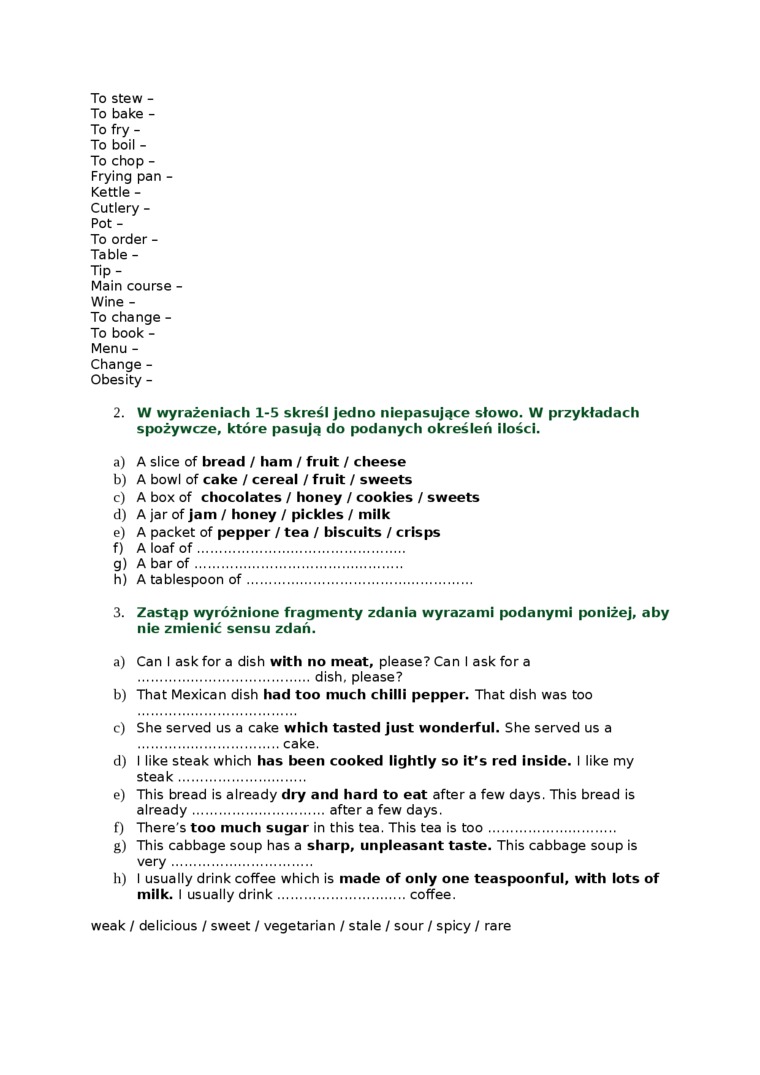83975

To stew -To bakę -To fry -To boil -To chop -Frying pan -Kettle -Cutlery -Pot-
To order -Table -Tip-
Main course -Winę -To change -To book -Menu -Change -Obesity -
2. W wyrażeniach 1-5 skreśl jedno niepasujące słowo. W przykładach spożywcze, które pasują do podanych określeń ilości.
a) A slice of bread / ham / frult / cheese
b) A bowl of cake / cereal / fruit / sweets
c) A box of chocolates / honey / cookies / sweets
d) A jar of jam / honey / piekłeś / milk
e) A packet of pepper / tea / biscuits / crisps
f) A loaf of...............................................
g) A bar of...............................................
h) A tablespoon of...................................................
3. Zastąp wyróżnione fragmenty zdania wyrazami podanymi poniżej, aby nie zmienić sensu zdań.
a) Can I ask for a dish with no meat, please? Can I ask for a .......................................dish, please?
b) That Mexican dish had too much chilli pepper. That dish was too
c) She served us a cake which tasted just wonderful. She served us a ................................cake.
d) I like steak which has been cooked lightly so it's red inside. I like my
steak.............................
e) This bread is already dry and hard to eat after a few days. This bread is
already..............................after a few days.
f) There’s too much sugar in this tea. This tea is too.............................
g) This cabbage soup has a sharp, unpleasant taste. This cabbage soup is
very................................
h) I usually drink coffee which is madę of only one teaspoonful, with lots of
milk. I usually drink.............................coffee.
weak / delicious / sweet / vegetarian / stale / sour / spicy / rare
Wyszukiwarka
Podobne podstrony:
% of the number of independent variablcs to be tested, only main cffccts werc initially fittcd; relc
18457b7bd8a2a7cecef380c9782e01fd verb noun it is my recommendation to you as regar
23vcg04 W Microsoft Word - AfitCore B0C Ę File Edit View Insert Format To ols Tąble Window Help □
23vcg07 W Microsoft Word -helpex H0B Q File Edit View Insert Format To ols Tąble Windo w Help _[Sjx
23vcg10 W Microsoft Word -helpex HEIIS Q File Edit View Insert Format To ols Tąble Windo w Help _[S
35vbu20 matm File Edit View Help to Customer Information to Order information for Mulligan s Press P
44d659f47d3783e131db66c89b02d35e aute couture is afashion never-never land in which made-to-ord
Buy It Now Buy It Now. Click here to order ordeit proceiMd by 31H3ZOn.COm _ Wt
partstopleft Parts Hangar CLI CK HE RE TO ORDER PARTS RELATED TO THE CONTENT ON TH1S
ProgramProdukcjiSTAR07 ■ &**>?*# *322* that time madę it possible to overhaul thoroughly
CHCESZ ZAMÓWIĆ WIĘKSZE ILOŚCI TKANIN? WOULD YOU LIKE TO ORDER LARGER QUANTITIES OF
więcej podobnych podstron